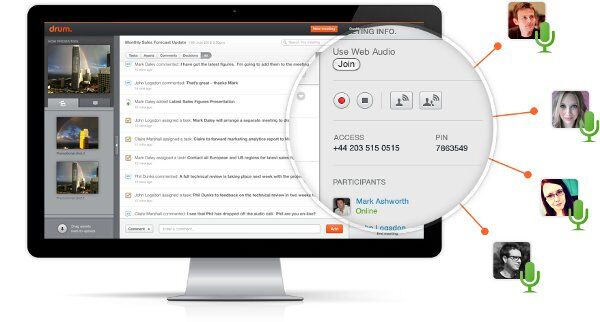[UPDATE: In 2019, Drum has pivoted and is no longer available as a standalone service]
Drum is here to change the way enterprises use collaboration.
Drum is a service that recently rolled out by NetDev. Based in the UK, this team has set its sights on improving the experience of online meetings. What I find most interesting is how the focus on the web (and WebRTC) dictates a different set of features and a different type of focus than the incumbents in this space (anyone said WebEx?).
I love how they have built stickiness and virality into their model in an enterprise domain – not a hard feat to do. Action items, decisions, summaries, recording and past archives are a part of their solution – things you usually don’t find in other such tools at such level of ease.

I’ve met John Logsdon, Drum’s Founder & CEO, at the WebRTC Conference in Paris. He agreed to answer a couple of my questions and share them with you on here.
What is Drum all about?
Drum is a real-time web meeting solution with an integrated audio conferencing capability. Drum can be used for business meetings, presentations, project updates and as a collaborative sales tool. It’s been developed with mobility in mind, so users can talk, meet and share from any connected location.
Drum supports the entire lifetime of the meetings and stores all documents and group interactions for every meeting you organize or attend. You can present documents, take notes, and assign tasks before, during and after any meeting.
Drum is an HTML5 application. Audio conferencing dial-in is supported from fixed/ mobile phones and directly through the browser, using WebRTC.
You have opted for arranging virtual meetings around users and not the IT Department. What was the reason?
Drum is a web application so by its very nature, it is open and available to anyone. Services delivered over the web attract users because they are easily accessible and offer an efficient, effective and often a new way of doing everyday things. When you look at Drum you have to think of it in a web context. Drum users can meet, talk, share and collaborate over the web; it doesn’t need the IT department to enable that. That’s not to say that we will never consider the IT department, but for now we are focused on ensuring Drum users have the simplest way to run the most effective and productive meetings possible.
What do you use as the identity for the users on Drum?
Users sign into Drum using their email address as their unique identity. They create a password and their account is stored locally. In the future we will support sign in with Google accounts and social network IDs.

You decided to focus on meetings and add voice to it. I assume you see video as secondary. Why?
We have a background in developing and supporting carrier-grade audio conferencing services. Our primary objective was to combine that expertise with WebRTC and offer a hybrid (traditional/WebRTC) audio conferencing capability from within Drum.
As we see it, the essential features for a web meeting are audio conferencing and the ability to share documents and other assets. We’d also argue that mobility is an important characteristic. Whilst video could certainly enhance the drum experience, we believe you can have a successful web meeting without it.
Having said that, we believe video does have a role to play and we’re taking time to analyze how it may improve a “mobility first” application like Drum. We’re currently looking at UI implications, extra bandwidth requirements and quality issues that may result from patchy signal areas. There is also the question of video codecs, but that’s another topic in its own right!
Can you explain your architecture a bit more?
Drum consists of audio and web components, which are securely connected via REST APIs and web sockets. The web component is a cloud service hosted by Drum HQ.
Drum audio conferencing is a software solution that runs on commodity hardware (we recommend Dell R410 X86_64 Intel Zeon, two socket, quad core/ 2.66GHz). It can be hosted by service providers within their data center and integrated with existing network management systems via REST APIs. The conferencing software enables users to dial into their meeting from fixed line, mobile and via the browser using WebRTC.
Browser initiated WebRTC calls go from the browser to the web component using Jingle as the signaling protocol. The web component has a Jingle to SIP gateway which forwards the WebRTC call as a normal SIP call to the Drum conferencing software. All voice traffic, regardless of origination, is mixed into a conference by the software.
What about the backend. Do you rely on a generic cloud service like AWS?
Yes, we use Amazon Web Services. We chose AWS because it allows us to grow Drum rapidly and economically. It’s also a trusted and secure service.
What challenges did you encounter with WebRTC?
From a development point of view, implementing STUN negotiation and the SDP-Jingle translation were major challenges.
Most of the problems we encountered related to the immaturity of the standard. There were several evolutions of the API and new releases of Canary sometimes resulted in problems with WebRTC, which we spent a lot of time debugging. Since WebRTC is now supported in the stable release of Chrome, these issues are no longer a problem and WebRTC is pretty stable. I should add that despite the problems we had, the support from Chrome developers was fantastic.
What would you change in WebRTC?
Overall we’re happy to embrace WebRTC exactly as it is. It needs to remain simple, flexible and not take on too much application logic.
From a Drum perspective we’d like to see support for desktop sharing. We’d also like to see widespread browser adoption, particularly for mobile. As the standard evolves and compelling new WebRTC applications and services are introduced, we’re convinced that the browsers will follow.
What’s next for Drum?
We are working on a new Drum meeting widget which will enable “meet instantly” from any website or web application. There are also a number of new features in the Drum incubator:
- Drum Cloud Files: Integration with Dropbox, Google Drive and Box.Net enabling users to add and present documents from their tablet or smartphone.
- Location Information: Integration with Google Maps to provide user location information and automatic display of correct conference call access number (based on a user’s location)
- Social network sign-in: Ability to log-in to Drum using Facebook, Google or Twitter IDs.
- Social Media Publishing: Use social media channels to publish meeting invites, summaries etc.

Hi Tsahi,
This is an interesting interview.
Being a part of Enterprise commucniation for years now – have a very basic question around “security”. Sharing official data on the web is not a tradition except there are good controlled measures in place.
What can be the probable challenges in adopting browser based solutions like Drum in enterprise scenarios?
Thanks,
Anant,
You are askig about the same organizations that use SalesForce and WebEx? In what way are they different?
Same challenges exist there with their hosted solutions that Drum is addressing today.
Thanks Tsahi for your response.
I absolutely agree with you but I am actually referring to organizations who have deployed their conferencing solutions (for audio, video and web) in house and managing internally instead of using the solutions like webex…
Hi Tsahi,
This is an interesting interview.
Being a part of Enterprise commucniation for years now – have a very basic question around “security”. Sharing official data on the web is not a tradition except there are good controlled measures in place.
What can be the probable challenges in adopting browser based solutions like Drum in enterprise scenarios?
Thanks,
Anant,
You are askig about the same organizations that use SalesForce and WebEx? In what way are they different?
Same challenges exist there with their hosted solutions that Drum is addressing today.